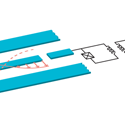How to accelerate the wall of an optical waveguide
When two conducting plates are brought in close proximity, they experience an attraction to one another. This pressure, called the Casimir effect, is a direct result of the quantum mechanical nature of light in a vacuum: more virtual photons can be created in the space outside of the plates than between them, which pushes them together.
Oscillating one of these plates can generate real photons, but no one has observed this dynamical Casimir effect, mainly because it would involve moving a macroscopic mirror at close to the speed of light.
In a paper appearing in Physical Review Letters, Robert Johansson and Franco Nori at RIKEN in Wako-shi, Japan, in collaboration with Göran Johansson and Christopher Wilson at Chalmers University of Technology in Sweden have worked out the theory explaining how the dynamical Casimir effect could be observed in a quantum cavity. The system they consider is a coplanar waveguide coupled to a superconducting quantum interference device (SQUID)—a device that is already a mainstay of proposals for quantum computing. Their idea is to apply an oscillating magnetic flux to the SQUID, which would modulate the effective length of the optical waveguide—analogous to moving the mirror in the original conception of the dynamical Casimir effect.
While the experiments to see the effect will by no means be easy, Johansson et al. take pains to consider the realistic limits of the devices, and suggest that the measurements are within reach, given current technology. – Jessica Thomas





